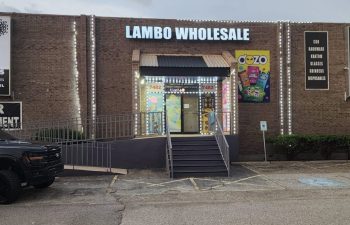Shayla Windstar talks transformation, motherhood, and the mystical allure of fire.
She’s been staring into the flames for more than a decade—and it’s paid off. Shayla Windstar picked up the flameworker’s torch at her mother’s Pueblo, Colorado head shop in the mid-aughts and never looked back. Perhaps you’ve witnessed her triumphant moments at national competitions or even possess one of her exquisite creations. Regardless, Shayla has made a name for herself in this industry, and her future plans are smokin’.

Glass blowing is very healing and nurturing. People have been staring into fire - praying and meditating - for thousands of years.
It was at her mother’s shop, Mary Jane’s Haberdasher, that Windstar was first introduced to the craft. The shop regularly hosted traveling artists who would sit for glass blowing demonstrations in the front windows, enticing customers, and as it turned out, Shayla as well. As a creative kid with a bit of a self-described pyro streak, she felt a spark. If you’ve ever lost time staring into a campfire, you can begin to understand the draw.
Glassblowing is an ancient art. Syrians as far back as 300 BCE are credited with creating the blow pipe that modern glass blowing is built on, but humans have been working with glass since 4000 BCE when our prehistoric ancestors used naturally occurring obsidian from volcanic eruptions in tools and amulets. “Glass blowing is very healing and nurturing. People have been staring into fire – praying and meditating – for thousands of years.” Windstar said. And it’s no different for her.
Throughout her ten-year journey, she’s undergone profound personal growth, transitioning to being a mother and embracing her power both as a woman and an artist. This journey hasn’t been without its challenges. The glass art and cannabis sector, though evolving, remains predominantly male-dominated. However, she emphasizes the growing support network among women in the industry – a bond that she believes creates resilient women. “It’s really centered the way I feel about not only my art but my life and the path I’m walking. It’s all kind of intertwined – a dream of discovery and growth and just, I don’t think it’s ever gonna stop,” she added.
Pyro to Pioneer
Shayla began to learn the very basics of the craft through sporadic artist interactions at Mary Jane’s Haberdasher. Having never had a formal apprenticeship, this is how she learned. “I worked with multiple artists who would come in to sell their glass who’d spend maybe ten to fifteen minutes showing me something on the torch and then move on,” Windstar said. “Brock Sibley was the first one to show me drawing with glass on glass and was very influential in my career.”
What she’s referencing is the stringer technique, which is the use of thin rods or threads of glass to create intricate patterns and detail on a glass piece – kind of similar to pulling taffy. The stringer technique requires a steady hand and a keen eye for detail, and it’s one of the many techniques that glass artists use to bring their visions to life. It became the foundation for what would eventually become Windstar’s signature style, what she refers to as stained glass technique. “I would watch my dad creating stained glass as a child, which was very influential,” she continued.
In the beginning, it was a grind. Shayla was churning out glass pipes working minimum wage for 40 hours a week, and not least of all, a new mother to an infant. Now nearly 10 years old, Shayla’s daughter grew up in the shop for at least the first year and a half of her life, often tucked into a pack ‘n play with her toys while mom worked, honing her skills, and building a business alongside it. “I’m lucky that I went to business school and could translate those skills into pursuing something that I loved.”
There’s just something about being able to stare into the fire. The rest of the world just melts away and it allows you this little piece of control over one of the hardest mediums on the planet. It’s like magic.







Pictured: “Owl Medicine”; a solo piece created by Shayla and donated to the Michigan Glass Project (MGP) for their November 2023 auction. The MGP is a collaborative initiative that partners with Art Road, a Detroit nonprofit aimed at reintroducing art classes into Detroit Public Schools.
Photos: Jamie Zill | @jlzill
With a background in business management, she had an edge when managing the commercial aspects of her art, but Shayla sees success on multiple levels. Financial success, sure, but there is an intrinsic value in creating beautiful things working with a medium that you love. “I feel truly blessed that I get to be a part of this incredible industry. And to be something of a spokesperson for women in the industry – because there aren’t a lot of us. But there is this beautiful energy behind the women in this community . . . we’re all willing to reach out and help those around us.”
Windstar’s commitment to altruism and community engagement shines through her collaboration with several charitable organizations, all of which are making tangible differences in the lives of the people they help. Organizations like the Michigan Glass Project, whose mission is to unite artists through charitable events and introduce art into Detroit classrooms to foster positive community change—or the Injured Artist Fund, sponsored by Glass Vegas, which aids artists facing personal catastrophes through donated and auctioned off works from contributing artists.
Looking ahead, she envisions herself traveling globally, collaborating with artists, and focusing on teaching—particularly veterans and those battling PTSD—in a larger home studio that can accommodate more students. For now, her plans remain two-pronged: short-term strategies alongside long-term dreams. As she readies herself for forthcoming competitions like Glass Vegas and CHAMPS, her message to budding artists is clear: Never give up. The world of glass blowing is challenging, but the results are incredibly rewarding. “I just want to convey how blessed I feel. And I’m incredibly proud of what this industry has done. There’s just something about being able to stare into the fire. The rest of the world just melts away and it allows you this little piece of control over one of the hardest mediums on the planet. It’s like magic.”




















